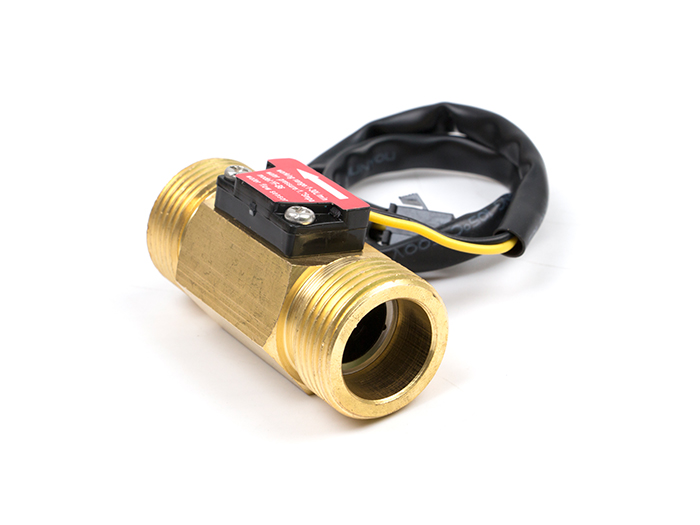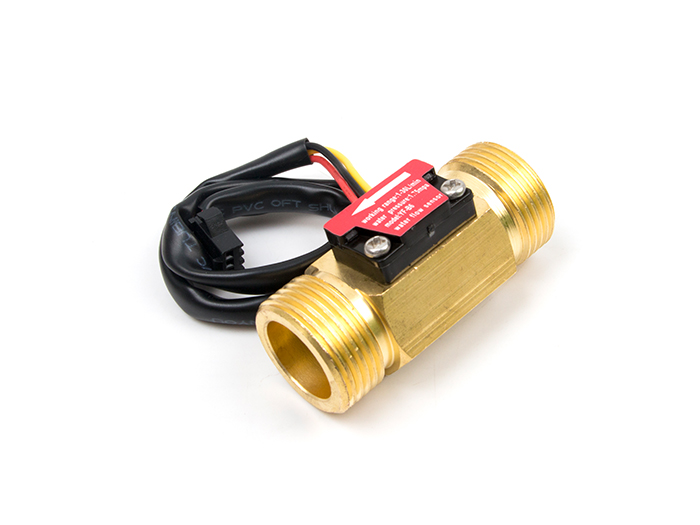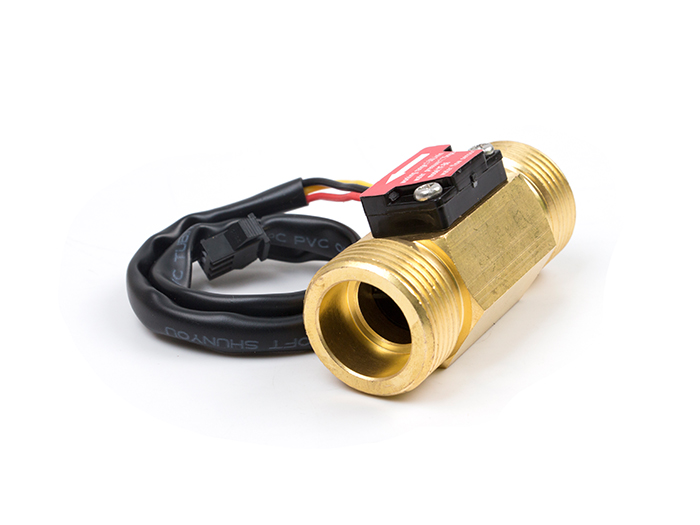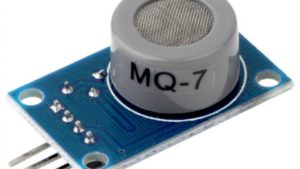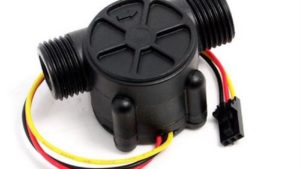Description
Water flow sensor consists of a copper body, a water rotor, and a hall-effect sensor. When water flows through the rotor, rotor rolls. Its speed changes with different rate of flow. The hall-effect sensor outputs the corresponding pulse signal. This one is suitable to detect flow in water dispenser or coffee machine.
Life is longer than plastic body.
Features
- Compact, Easy to Install
- High Sealing Performance
- High Quality Hall Effect Sensor
- RoHS Compliant
Specifications
- Mini. Working Voltage: DC 4.5V
- Max. Working Current: 15mA (DC 5V)
- Working Voltage: DC 5V~15V
- Flow Rate Range: 1~30L/min
- Frequency: F=6.6*Q(Q=L/MIN)
- Load Capacity: ≤10mA (DC 5V)
- Operating Temperature: ≤80℃
- Liquid Temperature: ≤120℃
- Operating Humidity: 35%~90%RH
- Water Pressure: ≤1.75MPa
- Storage Temperature: -25~+ 80℃
- Storage Humidity: 25%~95%RH
Getting started with the G3/4″ Thread Hall Effect Liquid Water Flow Sensor Switch Flow Meter
This is part of a project I have been working on and I thought I would share it here since there have been a few threads on how to read water flow rate in liters per min using the Water Flow Sensor .
Hardware required
- Arduino Uno
- Jumper wires
- G3/4″ Thread Hall Effect Liquid Water Flow Sensor Switch Flow Meter
- Resistor 10k
Connecting the Hardware
Wiring up the Water Flow Sensor is pretty simple. There are 3 wires: Black, Red, and Yellow. Black to the ground pin Red to 5v pin The yellow wire will need to be connected to a 10k pull up resistor.and then to pin 2 on the Arduino.

Upload the sample sketch
Measure the liquid/water flow rate using this code.
Connect Vcc and Gnd of sensor to arduino, and the
signal line to arduino digital pin 2.
*/
byte statusLed = 13;
byte sensorInterrupt = 0; // 0 = digital pin 2
byte sensorPin = 2;
// The hall-effect flow sensor outputs approximately 4.5 pulses per second per
// litre/minute of flow.
float calibrationFactor = 4.5;
volatile byte pulseCount;
float flowRate;
unsigned int flowMilliLitres;
unsigned long totalMilliLitres;
unsigned long oldTime;
void setup()
{
// Initialize a serial connection for reporting values to the host
Serial.begin(9600);
// Set up the status LED line as an output
pinMode(statusLed, OUTPUT);
digitalWrite(statusLed, HIGH); // We have an active-low LED attached
pinMode(sensorPin, INPUT);
digitalWrite(sensorPin, HIGH);
pulseCount = 0;
flowRate = 0.0;
flowMilliLitres = 0;
totalMilliLitres = 0;
oldTime = 0;
// The Hall-effect sensor is connected to pin 2 which uses interrupt 0.
// Configured to trigger on a FALLING state change (transition from HIGH
// state to LOW state)
attachInterrupt(sensorInterrupt, pulseCounter, FALLING);
}
/**
* Main program loop
*/
void loop()
{
if((millis() – oldTime) > 1000) // Only process counters once per second
{
// Disable the interrupt while calculating flow rate and sending the value to
// the host
detachInterrupt(sensorInterrupt);
// Because this loop may not complete in exactly 1 second intervals we calculate
// the number of milliseconds that have passed since the last execution and use
// that to scale the output. We also apply the calibrationFactor to scale the output
// based on the number of pulses per second per units of measure (litres/minute in
// this case) coming from the sensor.
flowRate = ((1000.0 / (millis() – oldTime)) * pulseCount) / calibrationFactor;
// Note the time this processing pass was executed. Note that because we’ve
// disabled interrupts the millis() function won’t actually be incrementing right
// at this point, but it will still return the value it was set to just before
// interrupts went away.
oldTime = millis();
// Divide the flow rate in litres/minute by 60 to determine how many litres have
// passed through the sensor in this 1 second interval, then multiply by 1000 to
// convert to millilitres.
flowMilliLitres = (flowRate / 60) * 1000;
// Add the millilitres passed in this second to the cumulative total
totalMilliLitres += flowMilliLitres;
unsigned int frac;
// Print the flow rate for this second in litres / minute
Serial.print(“Flow rate: “);
Serial.print(int(flowRate)); // Print the integer part of the variable
Serial.print(“L/min”);
Serial.print(“t”); // Print tab space
// Print the cumulative total of litres flowed since starting
Serial.print(“Output Liquid Quantity: “);
Serial.print(totalMilliLitres);
Serial.println(“mL”);
Serial.print(“t”); // Print tab space
Serial.print(totalMilliLitres/1000);
Serial.print(“L”);
// Reset the pulse counter so we can start incrementing again
pulseCount = 0;
// Enable the interrupt again now that we’ve finished sending output
attachInterrupt(sensorInterrupt, pulseCounter, FALLING);
}
}
/*
Insterrupt Service Routine
*/
void pulseCounter()
{
// Increment the pulse counter
pulseCount++;
}
NOTE: IF you get stray ‘223’ errors ,stray ‘226’ in program The problem is with your ” / = ( and ” ) – * > characters. Replace them with ordinary quotes ” / = ” () – * > and you should be fine.
Testing the circuit
Once you have it wired up you will need to upload the following code . Once it is uploaded and you have some fluid flowing through the Water Flow Sensor, you can open the serial monitor and it will display the flow rate.


